You’re jamming out, lost in the groove, but something’s missing. Your guitar amp just isn’t delivering the volume you crave. It’s like a lion that’s lost its roar. But don’t fret (pun intended); you’re about to discover how to make your guitar amp sound louder. Yes, we’re talking about turning that meek kitten of an amp into a full-blown, roaring beast!
You can use the table of contents below to take you to the area that interests you. Click on the little box to open it, and then click on the section of the article you want to read, or you can read from start to finish if you want the full guitar amp experience!
The Short Answer
To make your guitar amp sound louder, try simple tweaks like adjusting the EQ and gain settings before using dirt pedals, high-output pickups, or micing your amp. Louder isn’t always better. Achieving the perfect amp volume is a fine art that goes beyond simply cranking up the knob. It’s a balanced blend of the right gear, mindful settings, and a keen understanding of both the science and emotion behind the sound.
Keep On Reading (Below) To Learn More
Why Does Amp Volume Matter?
Volume isn’t just about being heard; it’s about feeling the music. When you’re playing live, your amp’s volume can make or break your performance. A louder amp can cut through the mix, ensuring that your guitar doesn’t get lost among the drums and vocals.
But it’s not just about live gigs. Even in your practice sessions, a louder amp can give you a clearer sense of your tone and technique. Plus, let’s be honest, cranking up the volume just feels good. It’s like your guitar is shouting, “Hey, listen to me!”
Common Mistakes That Lower Your Amp’s Volume
Using The Wrong Cables
You might not think much of it, but the cables you use can significantly impact your sound. Cheap or damaged cables can result in signal loss, making your amp sound quieter than it should. Always opt for high-quality cables and keep them in good condition. It’s a small investment that can make a big difference!
Poor Amp Placement
Where you place your amp matters. If your amp is on the floor, shoved in a corner, you’re doing it a disservice. Sound waves can get trapped or absorbed, reducing the amp’s effective volume. Elevating your amp or placing it in an open space can help it project sound more efficiently.
You can put your amp on a stool or chair if it’s a small combo amp.
Quick Fixes To Boost Volume

Volume Knob
Sometimes, the simplest solutions are the most effective. Your amp’s volume knob is there for a reason, so don’t be shy—give it a twist! Increasing the volume knob can provide an immediate boost, but be mindful of the amp’s limitations.
Pushing it too hard can result in distortion, and not the good kind.
The Gain Knob
The gain knob controls the level of distortion in your sound. While it’s not directly related to volume, increasing the gain can make your guitar sound ‘bigger,’ creating the perception of increased loudness.
But be cautious; too much gain can make your sound muddy. It’s all about finding that sweet spot where your guitar “roars without growling.”
EQ Settings
The EQ (Equalization) settings on your amp are like the secret sauce to your sound. Tweaking the bass, mid, and treble knobs can not only improve your tone but also make your amp sound louder.
For instance, boosting the mids can help your guitar cut through the mix, making it seem louder without actually increasing the volume. It’s like a magic trick for your ears!
Using A Booster Pedal
A booster pedal might be your new best friend if you’re looking for an immediate volume boost. These pedals amplify the signal before it reaches your amp, giving you that extra push. There are various options available, from budget-friendly to high-end. A popular choice is the TC Electronic Spark Mini, known for its clean boost that doesn’t alter your tone.
Here are five booster pedals that I’ve used with various guitars and amps. They range from budget-friendly to expensive, but they are all good choices for waking up your amp’s volume and really making it sing!
Donner Boost Killer: The Budget-Friendly Beast
If you’re just dipping your toes into the world of booster pedals, the Donner Boost Killer is a great starting point. Don’t let the affordable price tag fool you; this pedal packs a punch. It offers a clean boost that’s perfect for solos or for pushing your amp into natural overdrive.
The pedal also features a durable aluminum alloy body, ensuring it can withstand the rigors of gigging. And hey, it’s small enough to fit on any pedalboard without hogging space.
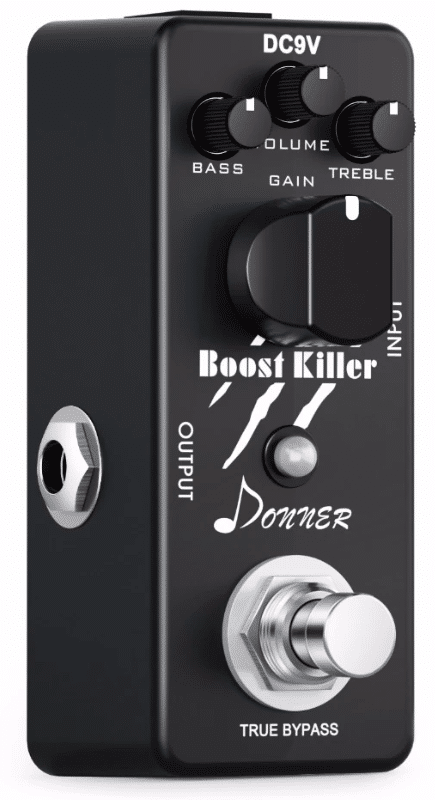
This pedal can be difficult to locate. I see them for sale on Reverb.com and eBay.
Electro-Harmonix LPB-1: The Vintage Vibe
The LPB-1 is a classic in the booster pedal world, and for good reason. It’s based on a design that dates back to the ’60s, giving it a vintage tone that many modern pedals try to emulate but rarely achieve.
This was my very first booster pedal. I bought it way back in high school in 1971! It was a more compact design that came in two configurations; one plugged into the amp and the other plugged into the guitar. I still have mine!
The pedal is straightforward, with a single knob controlling the boost level. It’s a no-frills option that focuses on doing one thing exceptionally well: making your guitar louder while preserving its natural tone.
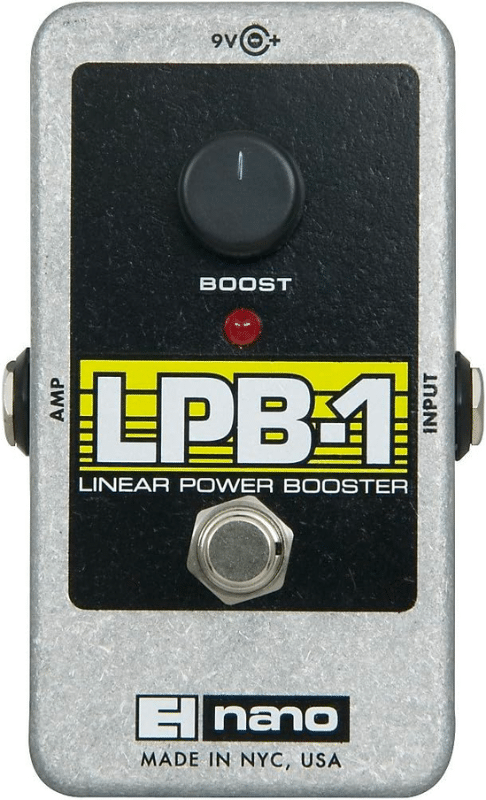
Click HERE To Check Reviews & Price On Amazon
TC Electronic Spark Mini Booster: The Compact Powerhouse
The Spark Mini Booster is the Swiss Army knife of booster pedals. Despite its small size, it offers a clean 20dB boost that can make your solos soar or give your rhythms extra punch.
One unique feature is its “PrimeTime” switching, which allows for both momentary and latching operation. This means you can either tap the footswitch for a quick boost or press it down for a continuous lift. Versatility in a tiny package!
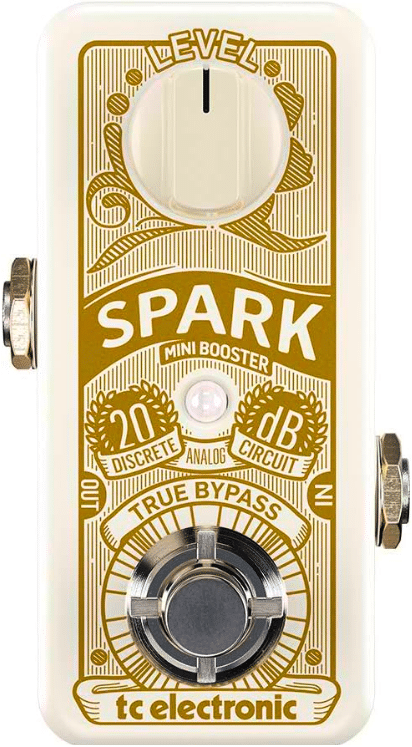
Click HERE To Check Reviews & Price On Amazon
Xotic EP Booster: The Tonal Chameleon
The EP Booster from Xotic is a bit of a legend in the guitar world. It’s inspired by the preamp section of the classic EP-3 tape echo unit, giving it a unique tonal character.
The pedal offers a wide range of boost options, from subtle to aggressive, making it incredibly versatile. It also has internal DIP switches for further tone shaping, allowing you to tailor the sound to your specific needs.

Click HERE To Check Reviews & Price On Amazon
(H4) Keeley Katana: The Premium Choice
If you’re looking for a booster pedal that offers both quality and versatility, the Keeley Katana is worth every penny. This pedal features high-grade components that provide a transparent boost, meaning it won’t color your original tone.
The Katana also offers a unique “pull” feature on its volume knob, allowing you to switch between a clean and a high-gain boost. It’s like having two pedals in one!
Most people are familiar with the mini version of this pedal, which retails for about $85. The Keeley Mini Katana has less functionality but is still a good unit.
Here is an image of the full-size unit (version 2):

This pedal can be difficult to locate. I see them for sale on Reverb.com and eBay.
Booster Pedal Comparison
| Booster Pedal | Price Range | Pros | Cons | Additional Info | True Bypass? |
|---|---|---|---|---|---|
| Donner Boost Killer | $ (Around $35) | Affordable, Simple to use | Limited tonal options | 3 EQ knobs, Up to +15dB boost | Yes |
| Electro-Harmonix LPB-1 | $$ (Around $45) | Vintage tone, Simple interface | No additional features | Based on classic design | Yes |
| TC Electronic Spark Mini | $$ (Around $70) | Clean boost, Compact | No EQ controls | 20dB boost | Yes |
| Xotic EP Booster | $$$ (Around $120) | Wide tonal range, Reliable | Slightly larger footprint | Up to +20dB boost | Yes |
| Keeley Katana | $$$$ (Around $200) | Versatile, High-quality components | Expensive | Both clean and high-gain modes | Yes |
Your Guitar Matters!

When it comes to cranking up the volume, your guitar plays a starring role. It’s not just about the amp; the type of guitar you use can significantly impact how loud you can go. Let’s explore some key factors.
High-Output (Passive) Pickups
If you’re serious about boosting your amp’s volume, consider the pickups on your guitar. High-output pickups can give your amp the extra juice it needs to reach those higher decibels. These pickups are designed to produce a stronger signal, which in turn drives your amp harder.
Brands like Seymour Duncan and DiMarzio offer a range of high-output options that can make your guitar a true volume warrior.
Active Pickups
While we’ve talked about high-output pickups, it’s crucial to mention the role of active pickups in this volume-boosting game.
Unlike their passive counterparts, active pickups have a built-in preamp powered by a battery. This preamp boosts the signal right at the source, giving you a hotter output that can seriously crank up your amp’s volume.
The EMG Edge
When it comes to active pickups, EMG is often the first name that comes to mind. Their EMG 81, for instance, is a staple in the metal community, known for its high output and sharp attack. It’s perfect for driving your amp to its limits, especially if you’re into genres that require a lot of gain.
Versatility
One of the advantages of active pickups is their versatility. Because they have a built-in preamp, you can often switch between different voicings, allowing you to go from a clean, crisp tone to a high-gain roar with the flip of a switch. This makes them incredibly versatile and well-suited for players who need a wide range of tones at their fingertips.
Battery Life
While the need for a battery might seem like a downside, most active pickups have a pretty impressive battery life, often up to 1,000 to 1,500 hours of playing time per pickup. Just remember to unplug your guitar when it’s not in use to conserve battery life.
Noise Reduction
Active pickups are generally less susceptible to noise and interference, thanks to their built-in preamp. This can be a significant advantage if you’re playing in settings with a lot of electrical noise, like a crowded bar or a venue with poor wiring.
Pickups Comparison
| Brand | Model | Type | Output Level | Price Range |
|---|---|---|---|---|
| Seymour Duncan | SH-6 Distortion | Passive | High | $$ |
| DiMarzio | Super Distortion | Passive | High | $$ |
| EMG | 81 | Active | High | $$$ |
| Fishman | Fluence Modern | Active | High | $$$ |
| Bare Knuckle | Warpig | Passive | Very High | $$$$ |
Speaker Selection And Amplifier Volume
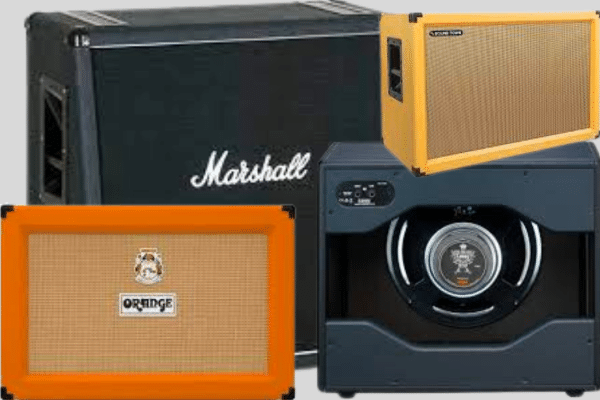
The right choice of speakers can make a guitar amplifier louder.
Speaker Efficiency: The Unsung Hero Of Volume
When we talk about making your amp louder, the conversation often revolves around pedals, pickups, and amp settings. But what about the speakers themselves? The efficiency of your amp’s speakers can play a significant role in how loud your setup can get.
Speakers with higher sensitivity ratings can produce more volume without requiring more power. This is especially useful if you’re working with a lower-wattage amp but still want to push the boundaries of its volume capabilities.
What Is Speaker Efficiency?
Speaker efficiency, often measured in decibels (dB), indicates how effectively a speaker converts power into sound. A speaker with higher efficiency will produce more volume using the same amount of power. For example, a speaker with an efficiency rating of 100 dB will be noticeably louder than one rated at 90 dB, even if both are driven by the same amp.
Sensitivity Ratings
When shopping for speakers or cabinets, you’ll often see a “sensitivity” rating. This is essentially another way of describing speaker efficiency. A higher sensitivity rating means the speaker will be more efficient at converting power to volume. Look for speakers with a sensitivity rating of at least 95 dB if you’re aiming for a louder setup.
The Celestion Factor
Brands like Celestion are renowned for producing highly efficient speakers. Models like the Celestion Vintage 30 not only offer a sensitivity rating of around 100 dB but also provide a tonal character that many guitarists love. It’s a win-win situation!
The Trade-Off
While higher efficiency often results in louder volume, it may also affect your tone. Highly efficient speakers can sometimes lack the warmth or richness found in less efficient models. It’s essential to consider both volume and tonal preferences when choosing speakers.
Understanding speaker efficiency can give you another tool in your quest for more volume, helping you make an informed decision when upgrading your amp or cabinet.
Using An Extension Cabinet
An extension cabinet can be a game-changer. By adding more speakers, you’re essentially increasing the surface area that projects the sound. This can result in a noticeable volume boost, giving your amp a fuller, richer tone that fills the room.
Adding an extension cabinet might seem like a straightforward way to boost your amp’s volume, but there’s more to it than just piling on extra speakers. An extension cabinet can fundamentally change the way your amp interacts with the room, providing not just more volume but also a richer, fuller sound.
Compatibility Matters
First things first, make sure the extension cabinet is compatible with your amp. Check the ohm rating and wattage to ensure they match. Mismatched cabinets and amps can result in poor performance and even damage your gear.
Speaker Configuration
Extension cabinets come in various configurations, from 1×12 (one 12-inch speaker) to 4×12 (four 12-inch speakers). The configuration you choose will affect not just the volume but also the tonal characteristics of your sound. For example, a 4×12 cabinet will not only be louder but also offer a fuller, more resonant tone.
Portability Vs. Power
Keep in mind that adding an extension cabinet means more gear to carry. If you’re a gigging musician, consider the trade-off between portability and volume. Some smaller cabinets offer a good balance, providing a significant volume boost without being too cumbersome.
Closed Vs. Open Back
The design of the cabinet itself can also impact your sound. Closed-back cabinets tend to produce a tighter, more focused sound, which can be beneficial for certain styles of music. Open-back cabinets offer a more spacious sound but may lack some of the low-end punch of their closed-back counterparts.
Micing The Amp: A Pro’s Secret Weapon
You’ve dialed in your tone, cranked up your amp, and you’re still not cutting through the mix. What’s the missing link? It might just be a microphone. Micing your amp can be a game-changer, not just for volume but also for sound quality.
The Right Mic For The Job
When it comes to micing your amp, the type of microphone you use can make a world of difference. Dynamic microphones like the Shure SM57 are industry standards for this purpose. They’re rugged, reliable, and excellent at capturing the nuances of a guitar amp.
Mic Placement Matters
The position of the microphone in relation to your amp’s speaker can dramatically affect the sound. Placing the mic dead center will capture brighter tones, while positioning it towards the edge of the speaker will yield a warmer, bassier sound. Experiment with different placements to find what suits your style best.
The Isolation Technique
If you’re playing in a setting with multiple instruments, isolating your amp and mic can help your guitar stand out. Some musicians use isolation boxes or even place their amp in a separate room, micing it up to capture a clean, uncolored sound.
The Multi-Mic Approach
For those looking to capture a more complex sound, using multiple microphones can be an effective technique. For example, you could use a dynamic mic like the SM57 for punch and clarity coupled with a ribbon mic like the Royer R-121 to capture the warmth and detail of a guitar amp.
Adding the Royer R-121 to your multi-mic setup can give you a tonal palette that’s both rich and versatile, allowing you to capture the full spectrum of your amp’s sound.
Live Vs. Studio
While miking your amp is common in the studio, it’s also invaluable in live settings. In a live mix, your guitar has to compete with drums, vocals, and other instruments. A well-placed mic can ensure your guitar cuts through the mix, allowing your riffs and solos to shine.
Micing your amp is more than just a volume-boosting tactic; it’s a nuanced technique that can elevate your sound to professional levels.
The Science Behind Amp Loudness

When you’re on the hunt for that perfect, ear-shattering volume, it’s essential to understand the science that makes it all possible. These principles can help you make more informed decisions when dialing in your amp settings or even when choosing a new amp altogether.
Let’s break down some key factors that contribute to amp loudness.
Wattage Vs. Decibels: The Real Deal
Wattage and decibels are two terms often thrown around when discussing amp loudness, but what’s the real relationship between them? While wattage indicates the electrical power your amp can handle, decibels measure the sound pressure level, or in simpler terms, the perceived loudness.
Contrary to popular belief, doubling the wattage doesn’t mean you’ll get a sound that’s twice as loud. In fact, to perceive a sound as twice as loud, you’d need about ten times the wattage! So, a 100-watt amp will only be twice as loud as a 10-watt amp, but it will offer more headroom for cleaner tones at higher volumes.
Wattage Vs. Perceived Loudness
| Wattage of Amp | Perceived Loudness | Headroom for Cleaner Tones |
|---|---|---|
| 10 Watts | Base Level | Limited |
| 20 Watts | Not Twice as Loud | Moderate |
| 100 Watts | Twice as Loud as 10 Watts | High |
The Fletcher-Munson Curve: The Human Element
The Fletcher-Munson Curve is a fascinating piece of science that explains how our ears perceive different frequencies at various volume levels. At lower volumes, our ears are less sensitive to extremely low and high frequencies.
This means that when you’re playing at bedroom levels, you might not get the full impact of your amp’s tonal range. As the volume increases, our ears become more sensitive to these frequencies, making the sound seem fuller and more balanced.
This is why many guitarists feel the need to crank up the volume to get that “perfect” tone; it’s not just about the amp; it’s also about how our ears work!
RMS Power Vs. Peak Power
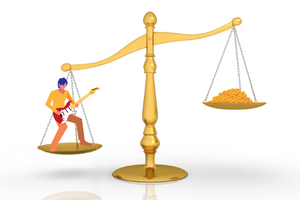
When it comes to understanding amplifier power, two terms often pop up: RMS (Root Mean Square) and Peak Power. These terms can be a bit confusing, but they’re crucial for understanding how loud your amp can get and how it performs under different conditions.
RMS power is essentially the “average” power your amp can handle over an extended period. It’s a more realistic measure of an amp’s capabilities, giving you an idea of the volume levels you can sustain without causing distortion or damage. When you see an amp rated at, say, 50 watts RMS, that’s a good indicator of its continuous power output.
Peak Power, on the other hand, is the maximum wattage an amp can handle in short bursts. While having an amp with a high peak power might sound impressive, it’s not a reliable measure of sustained performance. An amp might hit those high numbers for a split second, but it can’t maintain them without risking damage or distortion.
In practical terms, always look at the RMS rating when choosing an amp. It gives you a more accurate picture of what the amp can handle consistently, ensuring you get a reliable and quality sound.
Safety Precautions: Protect Your Gear and Ears!
When you’re on a quest for more volume, it’s easy to get carried away. But remember, with great power comes great responsibility—to your gear and your hearing!
Taking these safety precautions seriously can save you from a world of trouble down the line. After all, you can’t rock out if your gear or your ears are out of commission.
Protect Your Amp
Pushing your amp to its limits might give you that extra volume, but it can also lead to overheating and potential damage. Always make sure your amp has proper ventilation, and consider using a cooling fan if you’re running it hot for extended periods.
Check Speaker And Cabinet Compatibility
Mismatching your amp with incompatible speakers or cabinets can not only affect your tone but also risk damaging your equipment. Always check the impedance and wattage ratings to ensure they match between your amp and speakers.
Remember, your speakers need to be able to handle the extra decibels, so be sure you have enough room to safely kick up your sound.
Observe Electrical Safety
When you’re dealing with electrical equipment like amps and pedals, always ensure you’re plugged into a grounded outlet. This can prevent electrical shocks and potential damage to your gear.
Get Professional Input
If you’re planning to make any modifications to your amp to increase its volume, it’s always a good idea to consult a professional. Incorrect modifications can lead to permanent damage and may void your warranty. It can subject you to an electrical hazard if you don’t know what you are doing!
Use Ear Protection
Let’s face it: We all love the feeling of a roaring guitar solo, but our ears? Not so much. Prolonged exposure to high volumes can lead to hearing loss. Always use ear protection like earplugs when playing at high volumes, especially in confined spaces.
Expert Opinions On The Merits Of Amp Volume

When it comes to making your guitar amp sound louder, opinions vary among experts in the field. Let’s hear from music educators, professional guitarists, and guitar technicians on the subject.
These expert opinions offer valuable insights into the complexities of amp volume, advocating for a balanced and informed approach to achieving the loudness you desire.
Music Educators: The Science Of Sound
Music educators often emphasize the importance of understanding the science behind sound and amplification. They caution against simply cranking up the volume, as it can lead to distortion and a loss of tonal quality. Instead, they advocate for a balanced approach that considers the room acoustics, the amp’s capabilities, and the overall mix of instruments.
Professional Guitarists: Tone Over Volume
Many professional guitarists prioritize tone over sheer volume. They often use a combination of amp settings, pedal configurations, and playing techniques to achieve a full, rich sound without necessarily maxing out the volume knob.
Guitar Technicians: Gear Matters
Guitar techs are the unsung heroes behind every great guitar sound, and they have a wealth of knowledge about making amps sound louder. They often recommend specific gear upgrades, such as high-output pickups or more efficient speakers, to achieve a louder sound without pushing the amp to its limits.
My Personal Experience: Making Amps Louder

It all started in the good ol’ days of the ’60s when my ten-watt Sears Silvertone amp was the underdog in a band of older kids with equipment that made them sound like sonic titans. It seemed hopeless, with my amp’s feeble cries lost in a sea of rock ‘n’ roll thunder!
I tried to level the playing field with a game-changer: the Electro Harmonix LBP-1 (Linear Power Booster). This little gizmo was like my amp’s personal trainer, beefing up its muscles so my single-coil pickup guitar didn’t sound like a kazoo! Lol
THINGS CHANGED again when I got my hands on a 40-watt Fender Bandmaster amp. This bad boy had more headroom than a 10-gallon hat! Cranking it up between eight and ten, I could go from “clean and serene” to “overdrive dream” just by digging in with my pick.
Armed with my Fender Strat, I became a one-man effects army. The LBP-1 was my passport to “screaming solo land,” and the Screaming Bird treble booster was my VIP ticket to “cut-through-the-mix city.” For that Sabbath-esque crunch, my Big Muff Pi was the key to “Doomsville.”
As I ventured further into the realm of ear-shattering glory, I blew through speakers like they were tissue paper, finally settling on Electro-Voice 12-inch SROs. These 60-watt RMS, 300-watt peak power behemoths had so much junk in the trunk I had to remove the magnet covers just to squeeze ’em into my cabinet!
Sure, I was a gear-wrecking tornado back in the day, but man, did I have a blast.
The Moral Of The Story
Looking back, though, a little sage advice from the guitar gurus could’ve saved me some coin. So here’s my wisdom nugget for you: Invest in an amp and speakers that not only meet but exceed your volume needs. Trust me, your future self (and your wallet) will thank you!
The Volume Myth: Debunking The Need For Noise
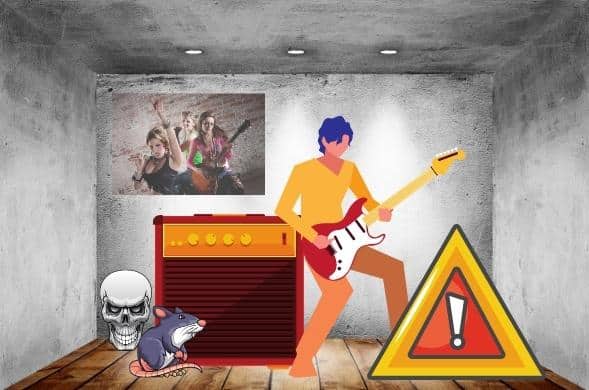
Alright, rockstars, let’s have a heart-to-heart. We’ve all been there. You’re jamming out, the adrenaline’s pumping, and you think, “Man, this would sound even better if it were LOUDER!”
That was me, through and through when I picked up my first electric guitar! But before you go turning that amp up to seismic levels, let’s chat.
First off, louder doesn’t always mean better. Ever heard of “ear fatigue”? It’s a real thing. Blast your tunes too loud, and you might find yourself getting tired of even your favorite riffs. Not to mention, you might tick off your neighbors, and trust me, you don’t want to be dealing with “that guy!”
Now, let’s talk dynamics. You see, music is a language, and like any language, it has its own form of punctuation. Sometimes, a well-placed pause or a softer passage can speak volumes (pun intended). Cranking it up to 11 all the time is like typing in ALL CAPS. Sure, you’ll get attention, but not the kind you want.
And hey, let’s not forget the mix. Going full throttle on your amp can drown out the other instruments if you’re playing with a band. You might be the lead guitarist, but remember, it’s a team effort. Your bassist and drummer deserve some sonic real estate, too!
Lastly, consider your gear’s lifespan. Amps, like all electronic devices, have their limits. Pushing your amp and speakers to the max regularly can lead to quicker wear and tear, meaning more trips to the repair shop and less time rocking out.
So, the next time you’re tempted to crank that volume knob, take a moment to consider the bigger picture. Sometimes, the sweet spot is found in moderation.
Key Takeaways

Here are five essential points to remember about making your guitar amp sound louder.
- Room Acoustics Matter: The size and shape of the room you’re playing in can significantly impact how loud your amp sounds. Consider room acoustics when setting your volume.
- Know Your Gear’s Limits: Every amp and speaker has its own limitations. Pushing them too hard can lead to unwanted distortion and even permanent damage.
- The Importance of a Sound Check: Always do a sound check before a live performance to ensure your amp’s volume is well-balanced with other instruments.
- The Role Of EQ Settings: Equalization can make a huge difference in perceived loudness. A well-EQ’d amp can sound louder without actually increasing the volume.
- The Listener’s Perspective: Sometimes, stepping away from your amp and listening from a distance can give you a better idea of its actual volume.
Are You Qualified To Make Amp Modifications?
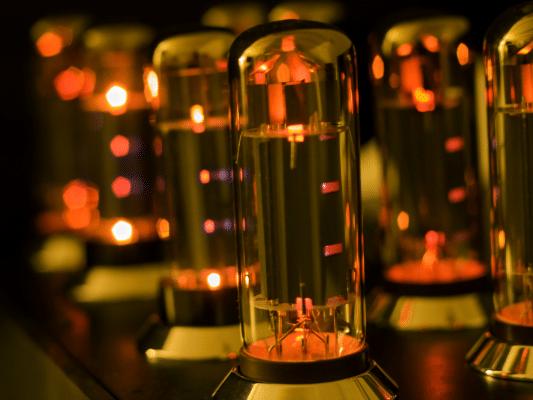
It’s great to work on your amplifiers, especially if you have a lot of them, but you should always be aware of your limitations.
Adjusting or modifying the electronics of a guitar amplifier can put you at risk for electrocution, which can seriously injure you or result in death, especially when working with tube amps!
Vacuum tubes run on 500 to 650 Volts or higher! So even if you unplug the amplifier, the electrolytic capacitors can still store a dangerously high voltage for an extended period of time.
When you doubt your ability to adjust, repair, or modify your amplifier, it’s always best to bring it to a certified repair center. You can damage your amplifier, which might never work or sound right again!
Modifying your amplifier can void its manufacturer’s warranty, even something as simple as speaker replacement! Certain modifications are irreversible, so you may be stuck with them, even if you desperately want to restore the amplifier to its original condition!
I learned that the hard way over the years until I did a three-year apprenticeship in a guitar and amplifier repair shop. Now I have my own home workshop with the proper training and equipment to re-bias, repair, and modify all my amplifiers safely.
Remember: “When In Doubt, Send It Out!”
Frequently Asked Questions

Here are some of the questions I get asked about guitar amplifier volume.
If your question does not appear here, please put it in the comments, and I will get right back to you with an answer.
Can I Use Multiple Amps For More Volume?
Yes, using multiple amps can increase your overall volume and offer a fuller sound. You can use more than one identical amp, like a wall of Marshalls, for more volume or several different amplifiers to get a richer and more complex sound.
Is A Tube Amp Louder Than A Solid-State Amp?
Tube amps are generally perceived as louder due to their tonal characteristics, even at the same wattage.
Can Pedal Order Affect My Amp’s Volume?
Definitely. The order of your pedals can impact the overall volume and tone. Experiment to find your sweet spot.
Do Different Guitar Strings Affect Volume?
Yes, heavier gauge strings generally produce a louder and fuller sound compared to lighter ones.
Is There A Difference Between Master And Channel Volume?
Absolutely. Master volume controls the amp’s overall output, while channel volume affects only the specific channel you’re using.
Can I Use A Power Attenuator To Control Volume?
Yes, a power attenuator can help you achieve high-gain tones at lower volumes. It sits between your amp and speaker, reducing volume without sacrificing tone.
What Is Headroom?
Headroom is the amp’s ability to handle increased levels while maintaining a clean tone when you turn up the volume control before distorting. This is especially important for styles of music that require clarity and precision.
Does More Watts Mean Louder?
More watts generally mean more potential for loudness, but it’s not a one-to-one relationship. For example, to perceive a sound as twice as loud, you’d need about ten times the wattage. So, a 100-watt amp will only be twice as loud as a 10-watt amp.
What you gain most with extra wattage is more headroom.
How Do I Get The Best Clean Guitar Tone?
Achieving the best clean guitar tone often involves a combination of factors like using high-quality cables, setting the right EQ, and choosing an amp with good headroom. Experiment with your amp’s tone controls, and consider using a compressor pedal to even out the dynamics for a cleaner sound.
What Happens If My Amp Is Not Powerful Enough?
If your amp isn’t powerful enough, you’ll likely struggle with low headroom, meaning the amp will produce unwanted distortion or “clip” when you try to turn up the volume. This can result in a loss of tone quality and may make it difficult to be heard in a band setting or larger venues.
Can An Amp Be Too Powerful?
Absolutely, an amp can be too powerful for certain situations. For example, a 100-watt amp might be overkill for a small bedroom or an intimate acoustic gig. Using an overly powerful amp in a small setting can lead to sound issues like unwanted distortion or feedback and can be impractical to manage.
Final Thoughts

In the quest to discover how to make your guitar amp sound louder, we’ve explored a variety of options. The possibilities are as vast as your musical imagination, from quick fixes like tweaking the EQ and gain settings to more involved strategies like micing your amp or using high-output pickups.
But remember, louder isn’t always better. Ear fatigue is real, and there’s an art to managing volume that goes beyond simply cranking up the dial. Sometimes, the most impactful musical moments come from the nuances, the ebb and flow of volume that adds depth to your sound.
We’ve also delved into the science behind amp loudness, discussing the relationship between wattage and perceived volume. It’s not just about the numbers; it’s about how those numbers interact with human hearing and room acoustics.
And let’s not forget the gear. From the quality of your cables to the efficiency of your speakers, every piece of equipment plays a role in your final sound. So before you go turning that volume knob to eleven, make sure the rest of your setup is up to the task.
In the end, achieving the perfect amp volume is a balanced blend of gear, settings, and a little bit of sonic wisdom. Rock on!

Here’s an excellent video from Sweetwater on understanding RMS power in an amplifier. Check it out!
Tell Me What You Think

Please leave a comment below if you enjoyed this article, have any questions about guitar amp volume, or want to give your point of view. I will be happy to help you.
- What is your favorite RMS power output in a guitar amp? Why?
- How do you get the best tone from your amplifier when you crank up the volume?
- What guitar amplifier would you buy if you could only have one? Why?
- What else is on your mind?

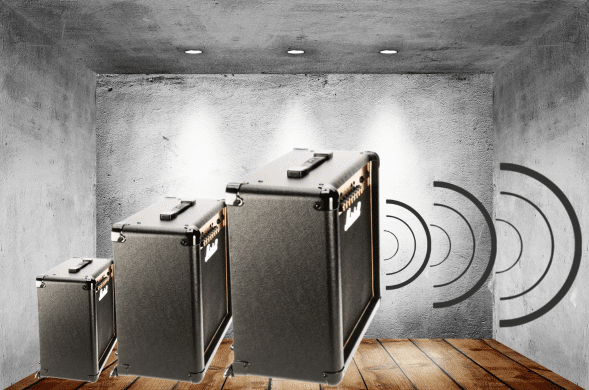

Fantastic read! As a guitarist looking to take my sound to the next level, this guide was exactly what I needed. The insights on selecting the right amp and upgrading pickups not only made a noticeable difference in my volume but also enhanced the overall quality of my tone. I especially appreciated the EQ adjustment tips, as they helped me fine-tune my sound to perfection. Incorporating a boost pedal into my setup was a game-changer, providing that extra kick and grit I craved. Plus, the advice on room acoustics opened my eyes to how the environment can impact my amp’s performance. Thanks for these invaluable tips – my guitar amp is now truly unleashed, and my music has never sounded better!
Hi Brian
Thank You for your comments!
I’m thrilled that the article helped you optimize your rig!
Rock On!
Frank
This excellent article provides a wealth of helpful tips on how to get more volume out of your guitar amp without sacrificing tone. I especially appreciate the emphasis on simple tweaks like adjusting the EQ and gain settings, as well as the recommendation to experiment with different options to find what works best for your individual amp and playing style.
Another great tip is the suggestion to use a booster pedal. Booster pedals can provide a clean boost in volume without altering your tone, which can be a great way to get your amp to cut through the mix without having to crank the master volume knob too high.
Overall, this is a well-written and informative article that will be valuable to any guitarist who wants to get the most out of their amp. Thanks for sharing!
Hi Ana
I appreciate your comments!
I’m really happy that you found the article helpful!
Rock On!
Frank